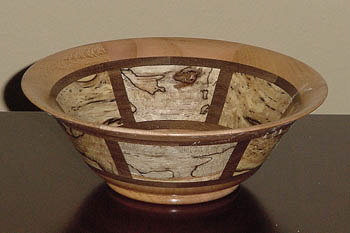 |
Design I begin by sketching
the bowl profile on grid paper. I also decide at this
point which woods to use, the thickness of each layer,
and how many segments I want the pattern to be based on.
|
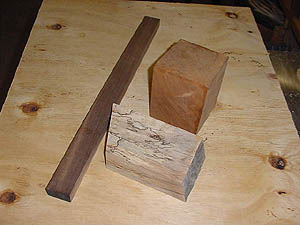 |
Materials I then try to see
if I actually have enough of each type of wood to finish
the job. This time it was easy since this will be a small
bowl. These are some scraps that I had laying around the
shop waiting for a project like this one. (Walnut,
cherry, and spalted pecan)
|
 |
Preparing the Stock I rip
the stock to the thickness that I'll need for each layer.
The square piece at the upper right will be the bottom
layer which will be solid. The small pieces at the lower
left will be inserted between the segments of the middle
layer. (We'll get to that part later.)
|
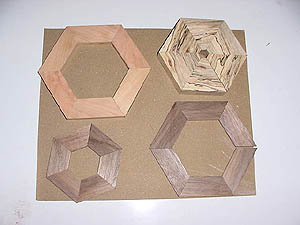 |
Cutting & Fitting the Segments I
failed to take a picture before I arranged the segments,
but the segments were just cut with a miter saw. This
picture shows the cut segments dry-fitted on a sheet of
sandpaper. This way I can determine how much sanding I
have to do to get a perfect fit. A slight touch up on the
disk sander on selected segments will get perfect joints.
|
 |
Getting the Perfect Fit Here
are the segments arranged again after sanding to get the
joints fitting perfectly. Also, the segments in the ring
on the upper right was cut too thick to make better use
of the scrap block it was cut from. I then ripped them
down afterwards to get closer to my design. This saves a
lot of roughing out when the blank gets to the lathe.
|
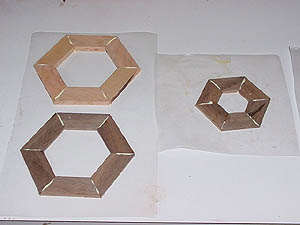 |
Gluing the Segments Here
some of the segments have been glued into rings and are
waiting to dry. With thin segments I just use hand
pressure to press the segments together.
|
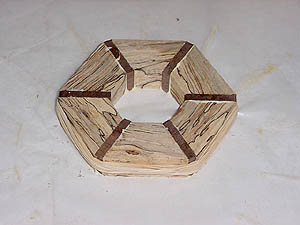 |
Gluing Larger Segments Here
is the middle layer with the straight pieces glued
between the mitered segments. Since it is large enough to
clamp I use a lot of cheap rubber bands to clamp the
ring. On even larger rings I sometimes use a band clamp.
|
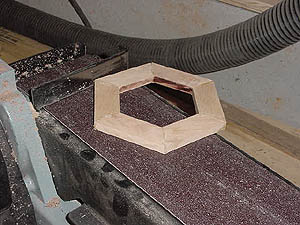 |
Flattening the Layers I use
a belt sander to flatten each side of the layers. This
gives perfect surfaces in order to glue the layers
together. There are many different ways this step can be
done, this is just how I do it. I hold the piece down on
the sander with light pressure with my left hand and keep
rotating it with my right hand until it is perfectly
smooth. Buy me a drum sander and I'll put it to good use.
|
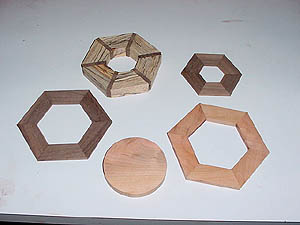 |
Ready for More Gluing Here
are the layers after they have all been sanded smooth on
both sides. Notice that I cut out a disc for the bottom
layer, it was also sanded smooth on the belt sander.
|
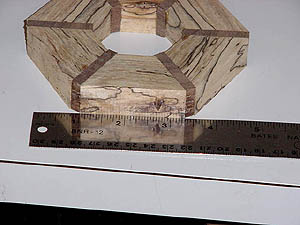 |
Marking the Rings I decided
to start with the middle layer. Here I measured and
marked the center of each segment for reference points.
This will help to get the rings centered while gluing.
|
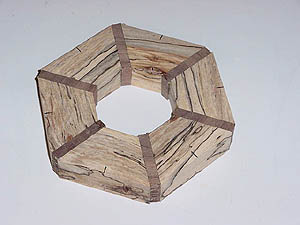 |
The lighter colored wood shows the marks very well.
Here the marks were extended to the upper surface (which
will be toward the bottom on the finished bowl) as well
as the sides. |
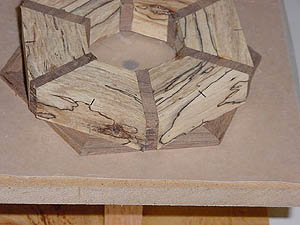 |
Checking the Match The
marks on the sides should line up with the joints of the
next layer. This centers the layers (unless you had to do
an excessive amount of sanding to get the joints to fit
in the ring), and it also separates the joints making
them less likely to fail under stress. Also, notice that
the grain in the straight walnut segments of the middle
layer lines up with the grain of the adjacent layer. This
makes the joint between them less visible and the
reflection of light will be nearly the same so you don't
readily notice that they are different pieces.
|
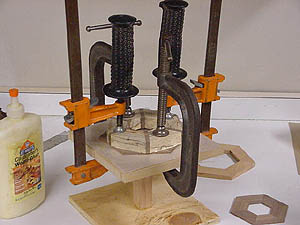 |
Gluing the First Layers Here
are the first two layers glued and clamped. I usually let
them cure for about 30 minutes before I go to the next
layer.
|
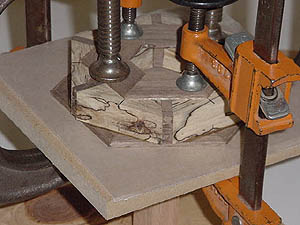 |
Gluing the Next Layer The
next layer is glued lining up the joints with the other
marks on the middle segment.
|
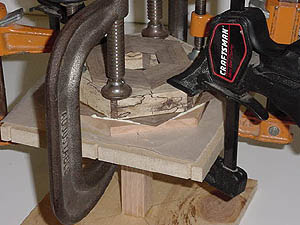 |
Gluing the Top Layer The
top layer (on bottom) is glued lining up the joints with
the segments of the middle layer.
|
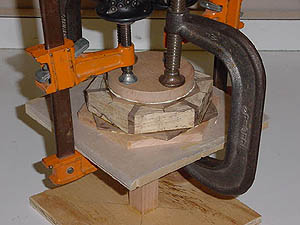 |
Gluing on the Solid Bottom The
solid disc is glued using the adjacent layer for
centering. If the disc had been significantly smaller
than the next layer then marks would have to be made to
get the centering correct.
|
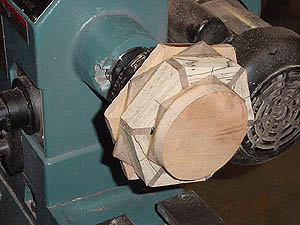 |
Mounting the Blank Now,
finally I have a blank to work with. Next comes the fun
part. I mounted the blank on the chuck expanding the jaws
in the interior. For larger bowls I would temporarily
glue the top layer to a scrap block mounted on a
faceplate. Before I got the chuck I glued a scrap block
to the bottom of the blank with a paper joint and screwed
it to a faceplate.
|
 |
Turning a Recess for the Chuck I
could have also gone ahead and shaped the outside of the
bowl at this point, but I wasn't comfortable with the
chuck security. (It's a 4 jaw chuck holding a 6 sided
piece.)
|
 |
Re-mounting the Blank Here
I am using spiggot jaws in the chuck to hold the blank in
the recess I just made.
|
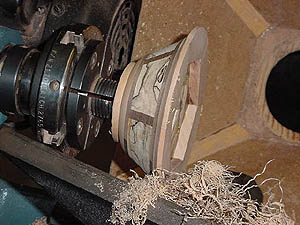 |
Turning the Outside Here
the outside is turned. Not necessarily an exact match to
the original design but close, and I like it.
|
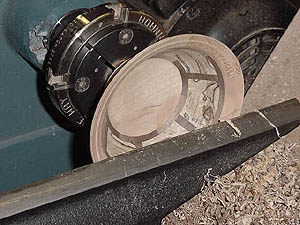 |
Turning the Inside I turned
the inside to match the outside with about 1/8 inch of
thickness and tapering thinner toward the rim.
|
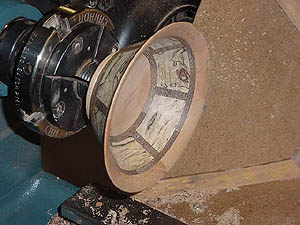 |
Sanding Here the inside and
outside are sanded to 220 grit. I would have gone finer,
but I was out of 320 grit. It still looked pretty good
like it was.
|
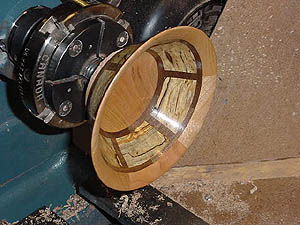 |
Finishing I applied a coat
of friction polish to the bowl as it was spinning. This
is not my favorite finish, but it looks pretty nice and
is very quick. Other finishes have to be applied after
the bowl is completed.
|
 |
Turning the Base I made a
jam chuck to hold the bowl in order to turn the base.
This chuck has been used before and will be used several
more times before it is discarded. I used a piece of
rubber drawer liner to hold the bowl in the recess. This
was the first time I used it, and it worked great. It's
really cheap too. A paper towel will also work.
|
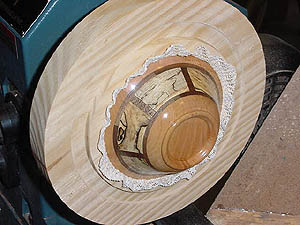 |
Finishing the Base After
turning and sanding the base I applied a coat of friction
polish to it. Now the bowl is finished.
|
